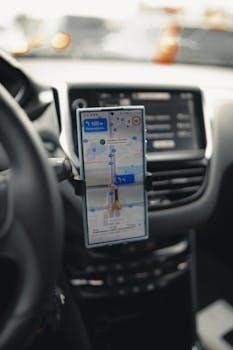Bushnell BackTrack GPS User Manual⁚ A Comprehensive Guide
Welcome to the ultimate guide for your Bushnell BackTrack GPS device! This manual provides detailed instructions and helpful tips to maximize your device’s potential. Learn to navigate with confidence and ease, ensuring you always find your way back.
The Bushnell BackTrack GPS is a user-friendly personal navigation device designed for outdoor enthusiasts. Its primary function is to guide users back to specific locations they have marked. Whether you’re hiking, camping, hunting, or simply navigating a parking lot, the BackTrack offers a simple and reliable solution. Unlike complex GPS systems with detailed maps, the BackTrack focuses on essential functionality⁚ marking waypoints and providing directional guidance. Its intuitive interface and ease of use make it an ideal tool for anyone seeking a straightforward navigation solution. The device utilizes GPS technology to acquire satellite signals and determine your current location, ensuring accurate navigation in various environments. With its compact design and long battery life, the Bushnell BackTrack is a valuable companion for any outdoor adventure. This manual will provide you with everything needed to operate the device.

Understanding the Device
This section explores the Bushnell BackTrack GPS device’s core functions and design. You will learn about its capabilities, limitations, and the basic principles that govern its operation for navigation.
Key Features and Benefits of the Bushnell BackTrack
The Bushnell BackTrack GPS offers unparalleled simplicity and reliability for outdoor enthusiasts. Its key feature is easy waypoint marking, allowing users to save locations like parking spots or campsites effortlessly. Navigation is straightforward, providing direction and distance back to saved points, ensuring you never get lost. The device is compact and lightweight, making it easy to carry on any adventure.
Benefit from its user-friendly interface, requiring minimal technical knowledge. The BackTrack’s robust design withstands various weather conditions, ensuring dependable performance. This device excels at basic GPS functionality, offering peace of mind for hikers, campers, and travelers. Enjoy the confidence of always finding your way back with Bushnell BackTrack.
Models Overview⁚ BackTrack, BackTrack Mini, D-Tour, and HuntTrack
Bushnell offers diverse BackTrack models catering to various needs. The standard BackTrack provides essential waypoint marking and navigation. The BackTrack Mini, a more compact version, often integrates with the Bushnell Connect app for enhanced features. The D-Tour model excels in trip data logging, enabling users to record and share their routes. This model offers a digital compass and the ability to save more locations.
Designed for hunters, the HuntTrack boasts specialized features like marking hunting spots and tracking game trails. Each model retains the BackTrack’s core simplicity while adding unique functionalities. Choose the model that best suits your outdoor activities and desired level of data tracking.

Getting Started
Embark on your navigational journey! This section guides you through initial setup. Learn about battery installation and powering on your Bushnell BackTrack. Prepare for your first adventure with these simple steps.
Initial Setup⁚ Battery Installation and Powering On
Begin by opening the battery compartment, usually located on the back of the device, by twisting the round cover clockwise. Insert two AAA alkaline or lithium batteries, ensuring they are oriented correctly according to the markings inside the compartment. Close the cover securely by rotating it counterclockwise.
To power on your Bushnell BackTrack, press and hold the MODE/Power button. The device requires a clear view of the sky for optimal GPS reception. Avoid indoor locations such as parking garages during initial startup.
The BackTrack will begin searching for GPS satellites, indicated by a flashing satellite icon. Allow a few minutes for the device to establish a connection. Once the icon stops flashing, your BackTrack is ready for use.
Acquiring GPS Signal⁚ Best Practices
For the best GPS signal acquisition, always use your Bushnell BackTrack outdoors with an unobstructed view of the sky. Trees, buildings, and other obstructions can interfere with the GPS signal, delaying or preventing a successful connection.
When powering on the device, remain stationary to allow it to lock onto satellites more easily. If you’re in motion, the device may take longer to acquire a signal or may lose the connection intermittently.
If you encounter difficulty acquiring a signal, try moving to a more open area. Ensure the device is held upright and away from your body to minimize interference. In areas with weak GPS coverage, it may take several minutes to establish a connection. Patience is key for optimal performance.
Basic Operation
The Bushnell BackTrack simplifies navigation with intuitive features. Learn to mark locations effortlessly and navigate back with clear direction and distance readings, ensuring you never lose your way.
Marking Locations⁚ Saving Waypoints
To mark a location on your Bushnell BackTrack, ensure you are outdoors with a clear view of the sky for optimal GPS reception. Press and hold the designated waypoint button until the device confirms the location has been saved. This action stores the current GPS coordinates as a waypoint. The device may take a few moments to lock onto GPS satellites; the satellite icon will stop flashing once locked.
Remember, the BackTrack has limited memory, so synchronizing with the Bushnell Connect app is advised to save and manage multiple waypoints. You can name and organize waypoints within the app for easy identification later. This streamlined process ensures you can easily return to important spots.
Navigating Back to Saved Locations⁚ Direction and Distance
Once you have saved a waypoint on your Bushnell BackTrack, navigating back is straightforward. Power on the device and select the desired waypoint from the stored locations. The BackTrack will then display the direction and distance to that specific location. The directional arrow indicates which way to walk, while the distance is shown in either miles or kilometers, depending on your settings.
Keep in mind that the accuracy depends on clear GPS signal reception. Obstructions like buildings or dense foliage may affect accuracy. Regularly check the display as you move to ensure you remain on course. The device guides you with real-time updates, making it easy to find your way.

Advanced Features (Depending on Model)
Explore advanced functionalities available on select Bushnell BackTrack models. These features enhance your navigation experience, offering tools like app connectivity, trip data logging, and customized settings for specific user needs.
Using the Bushnell Connect App (Mini Model)
The Bushnell Connect App enhances the functionality of your BackTrack Mini. Start by ensuring your Mini has sufficient memory. Sync with the app to save trips and waypoints, freeing up device storage. To connect, access the connection menu through the BackTrack Mini settings. Launch the Bushnell Connect App and tap the plus sign to pair your device. You will then be prompted to name your BackTrack Mini within the app.
Once synced, manage trips and waypoints within the app’s library. Trips and waypoints are organized by date or name. Share your adventures by selecting a trip and using the share button to send via email or text. The app is available on both Android and iOS.
Trip Data Logging and Sharing (D-Tour Model)
The Bushnell BackTrack D-Tour model offers advanced trip data logging capabilities. It allows you to record up to 48 hours of your journey, providing detailed information about your routes and activities. This feature is particularly useful for outdoor enthusiasts and adventurers who want to track their expeditions.
The D-Tour model enables users to upload their trip data to social networking sites, making it easy to share experiences with friends and family. The device also displays current and average speed. To share your trip data, connect your D-Tour to a computer and follow the instructions in the manual for uploading and sharing your data.
Troubleshooting and Maintenance
This section provides solutions to common issues encountered while using your Bushnell BackTrack GPS. Learn about battery care, signal problems, and general maintenance to keep your device in optimal condition for reliable navigation.
Common Issues and Solutions
Encountering issues with your Bushnell BackTrack? A frequent problem involves weak GPS signals, often resolved by ensuring you are outdoors with a clear sky view. If the device points in the wrong direction, recalibrate it following the manual’s compass instructions. Battery life can be extended by using lithium batteries and avoiding prolonged exposure to extreme temperatures.
If the BackTrack fails to save waypoints, clear some memory by syncing with the Bushnell Connect app and removing old data. For devices that won’t power on, try replacing the batteries, ensuring they are correctly installed. Should issues persist, consult the Bushnell website for updated firmware or contact their customer support for further assistance. Regular software updates from Bushnell address bug fixes and performance improvements.
Battery Care and Replacement
Proper battery care is crucial for optimal Bushnell BackTrack performance. Always use high-quality AAA alkaline or lithium batteries for best results. Lithium batteries tend to offer longer life, especially in cold weather conditions. To replace the batteries, twist the battery cover on the back of the device counterclockwise to open it. Insert the new batteries, ensuring they are aligned according to the polarity markings inside the compartment.
Avoid mixing old and new batteries, as this can reduce overall battery life and potentially damage the device. When not in use for extended periods, remove the batteries to prevent corrosion. Dispose of used batteries responsibly, following local regulations for electronic waste disposal. Regularly check the battery contacts for any signs of corrosion and clean them gently with a dry cloth if necessary.

Warranty and Support
Bushnell provides a warranty for your BackTrack GPS device. For assistance, consult the warranty details or contact Bushnell customer support for expert help with any issues or questions you may encounter.
Understanding the Bushnell Warranty
Bushnell warrants your BackTrack GPS unit to be free of defects. To view the full warranty and find details on how to request service under the warranty, visit the Bushnell website. Alternatively, you can request a copy of the warranty by calling customer support or writing to Bushnell at the provided addresses.
The warranty covers defects resulting from normal use but does not cover damage caused by misuse, abuse, or unauthorized modifications. Retain your proof of purchase for warranty claims. Understanding your warranty ensures you receive proper support if issues arise with your device.
Contacting Bushnell Customer Support
Need assistance with your Bushnell BackTrack GPS? Bushnell provides multiple avenues for customer support to address your questions and concerns. You can reach their support team via phone, email, or through their website’s support portal.
Visit the Bushnell website for FAQs, troubleshooting guides, and downloadable manuals. For personalized support, call their customer service hotline during business hours. When contacting support, have your device model number and proof of purchase ready. Bushnell’s dedicated team is committed to providing prompt and helpful assistance, ensuring you have a positive experience with your BackTrack GPS device and can resolve any issues quickly.